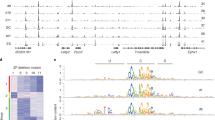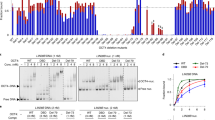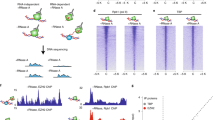Abstract
An open chromatin largely devoid of heterochromatin is a hallmark of stem cells. It remains unknown whether an open chromatin is necessary for the differentiation potential of stem cells, and which molecules are needed to maintain open chromatin. Here we show that the chromatin remodelling factor Chd1 is required to maintain the open chromatin of pluripotent mouse embryonic stem cells. Chd1 is a euchromatin protein that associates with the promoters of active genes, and downregulation of Chd1 leads to accumulation of heterochromatin. Chd1-deficient embryonic stem cells are no longer pluripotent, because they are incapable of giving rise to primitive endoderm and have a high propensity for neural differentiation. Furthermore, Chd1 is required for efficient reprogramming of fibroblasts to the pluripotent stem cell state. Our results indicate that Chd1 is essential for open chromatin and pluripotency of embryonic stem cells, and for somatic cell reprogramming to the pluripotent state.
This is a preview of subscription content, access via your institution
Access options
Subscribe to this journal
Receive 51 print issues and online access
$199.00 per year
only $3.90 per issue
Buy this article
- Purchase on SpringerLink
- Instant access to full article PDF
Prices may be subject to local taxes which are calculated during checkout





Similar content being viewed by others
References
Mikkelsen, T. et al. Dissecting direct reprogramming through integrative genomic analysis. Nature 454, 49–55 (2008)
Reddien, P. W. & Sanchez-Alvarado, A. Fundamentals of planarian regenaration. Annu. Rev. Cell Dev. Biol. 20, 725–757 (2004)
Terstappen, L. W. et al. Sequential generations of hematopoietic colonies derived from single nonlineage-committed CD34+CD38- progenitor cells. Blood 77, 1218–1227 (1991)
Spangrude, G. J., Heimfeld, S. & Weissman, I. L. Purification and characterization of mouse hematopoietic stem cells. Science 241, 58–62 (1988)
Meshorer, E. et al. Hyperdynamic plasticity of chromatin proteins in pluripotent embryonic stem cells. Dev. Cell 10, 105–116 (2006)
Efroni, S. et al. Global transcription in pluripotent embryonic stem cells. Cell Stem Cell 2, 437–447 (2008)
Grskovic, M. et al. Systematic identification of cis-regulatory sequences active in mouse and human embryonic stem cells. PLoS Genet. 3, e145 (2007)
Ventura, A. et al. Cre-lox-regulated conditional RNA interference from transgenes. Proc. Natl Acad. Sci. USA 101, 10380–10385 (2004)
Woodage, T. et al. Characterization of the CHD family of proteins. Proc. Natl Acad. Sci. USA 94, 11472–11477 (1997)
Sims, R. J. et al. Human but not yeast CHD1 binds directly and selectively to histone H3 methylated at lysine 4 via its tandem chromodomains. J. Biol. Chem. 280, 41789–41792 (2005)
Simic, R. et al. Chromatin remodeling protein Chd1 interacts with transcription elongation factors and localizes to transcribed genes. EMBO J. 22, 1846–1856 (2003)
Stokes, D. G., Tartof, K. D. & Perry, R. P. CHD1 is concentrated in interbands and puffed regions of Drosophila polytene chromosomes. Proc. Natl Acad. Sci. USA 93, 7137–7142 (1996)
Sims, R. J. et al. Recognition of trimethylated histone H3 lysine 4 facilitates the recruitment of transcription postinitiation factors and pre-mRNA splicing. Mol. Cell 28, 665–676 (2007)
Chen, X. et al. Integration of external signaling pathways with the core transcriptional network in embryonic stem cells. Cell 133, 1106–1117 (2008)
Niwa, H., Miyazaki, J. & Smith, A. G. Quantitative expression of Oct-3/4 defines differentiation, dedifferentiation or self-renewal of ES cells. Nature Genet. 24, 372–376 (2000)
Morrisey, E. E. et al. GATA6 regulates HNF4 and is required for differentiation of visceral endoderm in the mouse embryo. Genes Dev. 12, 3579–3590 (1998)
Bernstein, B. E. et al. A bivalent chromatin structure marks key developmental genes in embryonic stem cells. Cell 125, 315–326 (2006)
Lachner, M. & Jenuwein, T. The many faces of histone lysine methylation. Curr. Opin. Cell Biol. 14, 286–298 (2002)
Loh, Y.-H. et al. Jmjd1a and Jmjd2c histone H3 Lys 9 demethylases regulate self-renewal in embryonic stem cells. Genes Dev. 21, 2545–2557 (2007)
Takahashi, K. & Yamanaka, S. Induction of pluripotent stem cells from mouse embryonic and adult fibroblast cultures by defined factors. Cell 126, 663–676 (2006)
Okita, K., Ichisaka, T. & Yamanaka, S. Generation of germline-competent induced pluripotent stem cells. Nature 448, 313–317 (2007)
Maherali, N. et al. Directly reprogrammed fibroblasts show global epigenetic remodeling and widespread tissue contribution. Cell Stem Cell 1, 55–70 (2007)
Wernig, M. et al. In vitro reprogramming of fibroblasts into a pluripotent ES-cell-like state. Nature 448, 318–324 (2007)
Blelloch, R., Venere, M., Yen, J. & Ramalho-Santos, M. Generation of induced pluripotent stem cells in the absence of drug selection. Cell Stem Cell 1, 245–247 (2007)
Skottman, H. et al. Gene expression signatures of seven individual human embryonic stem cell lines. Stem Cells 23, 1343–1456 (2005)
Ramalho-Santos, M. et al. “Stemness”: transcriptional profiling of embryonic and adult stem cells. Science 298, 597–600 (2002)
Kimura, A., Umehara, T. & Horikoshi, M. Chromosomal gradient of histone acetylation established by Sas2p and Sir2p functions as a shield against gene silencing. Nature Genet. 32, 370–377 (2002)
Venkatasubrahmanyam, S. et al. Genome-wide, as opposed to local, antisilencing is mediated redundantly by the euchromatic factors Set1 and H2A.Z. Proc. Natl Acad. Sci. USA 104, 16609–16614 (2007)
McKittrick, E., Gafken, P. R., Ahmad, K. & Henikoff, S. Histone H3.3 is enriched in covalent modifications associated with active chromatin. Proc. Natl Acad. Sci. USA 6, 1525–1530 (2004)
Konev, A. Y. et al. CHD1 motor protein is required for deposition of histone variant H3.3 into chromatin in vivo . Science 317, 1087–1090 (2007)
Sridharan, R. et al. Role of the murine reprogramming factors in the induction of pluripotency. Cell 136, 364–377 (2009)
Ying, Q. L., Nichols, J., Evans, E. P. & Smith, A. G. Changing potency by spontaneous fusion. Nature 416, 545–548 (2002)
Reynolds, A. et al. Rational siRNA design for RNA interference. Nature Biotechnol. 22, 326–330 (2004)
Ivanova, N. et al. Dissecting self-renewal in stem cells with RNA interference. Nature 442, 533–538 (2006)
Li, C. & Wong, W. H. Model-based analysis of oligonucleotide arrays: expression index computation and outlier detection. Proc. Natl Acad. Sci. USA 98, 31–36 (2001)
Doniger, S. W. et al. MAPPFinder: using Gene Ontology and GenMAPP to create a global gene-expression profile from microarray data. Genome Biol. 4, R7 (2003)
Pfaffl, M. W., Horgan, G. W. & Dempfle, L. Relative expression software tool (REST) for group-wise comparison and statistical analysis of relative expression results in real-time PCR. Nucleic Acids Res. 30, e36 (2002)
Boyer, L. A. et al. Polycomb complexes repress developmental regulators in murine embryonic stem cells. Nature 441, 349–353 (2006)
Wernig, M. et al. A drug-inducible transgenic system for direct reprogramming of multiple somatic cell types. Nature Biotechnol. 26, 916–924 (2008)
Acknowledgements
The authors wish to thank A. Smith for Oct4-GiP ES cells, M. S. Parmacek for Gata6-/- ES cells, R. P. Perry and D. G. Stokes for the Chd1 antibody, M. Bigos and V. Stepps at the Flow Cytometry Core Facility and L. Ta and C. Barker at the Genomics Core Facility of the Gladstone Institutes for expert assistance, C. Chiu for technical assistance, members of the Santos laboratory, in particular M. Grskovic for advice, and A. Kriegstein, D. Melton, A. Alvarez-Buylla, D. Stainier, R. Blelloch, B. Panning, J. Reiter and M. Grskovic for discussions and critical reading of the manuscript. A.G.-M. was the recipient of a predoctoral fellowship from the Foundation for Science and Technology (POCI2010/FSE), Portugal. R.S. was the recipient of a CIRM postdoctoral training grant. This work was supported by grants from the Sandler Family to M.T.M., CIRM Young Investigator Award and NIH Director’s New Innovator Award to K.P., Israel Science Foundation (ISF 215/07), European Union (IRG-206872) and Alon Fellowship to E.M., and NIH Director’s New Innovator Award, California Institute for Regenerative Medicine and Juvenile Diabetes Research Foundation to M.R.-S.
Author Contributions A.G.-M., J.R.-S., M.T.M., K.P., E.M. and M.R.-S. planned the project; A.G.-M., A.A., F.P., R.S., M.J.M. and A.H. performed the experiments; A.G.-M., A.A., F.P., R.S., M.J.M., K.P., E.M. and M.R.-S. analysed the data; and A.G.-M., K.P., E.M. and M.R.-S. wrote the manuscript.
Author information
Authors and Affiliations
Corresponding author
Supplementary information
Supplementary Figures
This file contains Supplementary Figures 1-14 plus Legends. (PDF 6338 kb)
Supplementary Data
This file contains Supplementary Data 1: Normalized expression microarray data of control and Chd1 RNAi ES cells. (XLS 10540 kb)
Supplementary Data
This file contains Supplementary Data 2: Chd1 target genes in ES cells as determined by ChIP-chip. (XLS 432 kb)
Supplementary Table
This file contains Supplementary Table 1: Sequences of the short-hairpin RNAs used in the RNAi screen. (XLS 19 kb)
Rights and permissions
About this article
Cite this article
Gaspar-Maia, A., Alajem, A., Polesso, F. et al. Chd1 regulates open chromatin and pluripotency of embryonic stem cells. Nature 460, 863–868 (2009). https://doi.org/10.1038/nature08212
Received:
Accepted:
Published:
Issue Date:
DOI: https://doi.org/10.1038/nature08212



